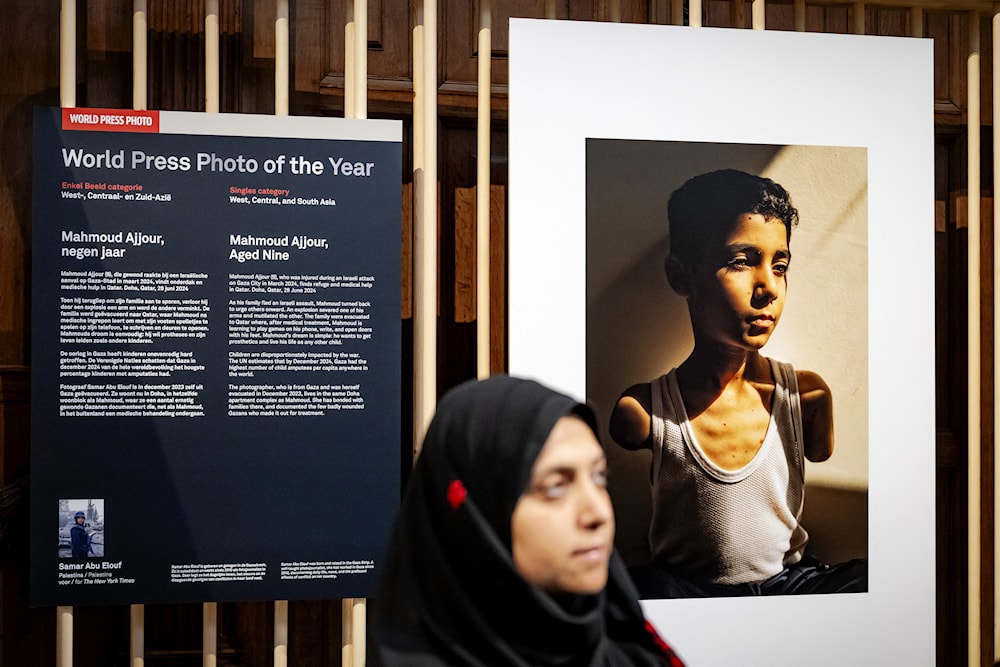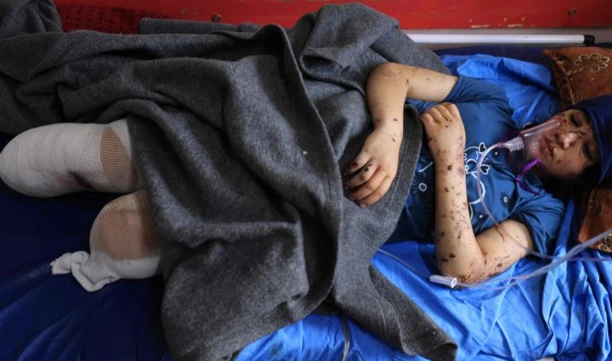Portrait of amputee Palestinian child named Press Photo of the Year
The winning photo of 9-year-old Mahmoud Ajjour, who lost both arms in an Israeli strike, vividly captures the devastating impact of war on the children of Gaza.
-

World Press Photo of 2025 award winner Palestinian photojournalist Samar Abu Elouf poses next to her winning photograph depicting a nine-year-old Palestinian boy who lost both arms during an Israeli attack on Gaza City at the Nieuwe Kerk in Amsterdam on April 17, 2025 (AFP)
The portrait of the Palestinian boy who lost both arms in an Israeli strike was named World Press Photo of the Year. The photo, taken by Qatar-based Palestinian photographer Samar Abu Elouf for The New York Times, shows 9-year-old Mahmoud Ajjour with his arms missing just below each shoulder.
The winner of the 68th edition of the prestigious photojournalism contest was selected from 59,320 entries submitted by 3,778 photographers from 141 countries.
In Gaza, the dire healthcare crisis has left thousands of children amputated, with many undergoing surgeries without anesthesia, leading to unimaginable suffering, as the territory's healthcare system has been severely damaged by "Israel’s" initial and renewed military assault.
Mahmoud is “learning how to live without his arms,” according to a statement from World Press Photo. He now needs help with basic tasks like eating and dressing.
“One of the most difficult things Mahmoud’s mother explained to me was how when Mahmoud first came to the realization that his arms were amputated, the first sentence he said to her was, ‘How will I be able to hug you?’” Abu Elouf said in a statement released by the World Press Photo organization.
“He is also learning to use his feet to do things like opening doors, writing and playing games on his phone,” the statement continued, noting that he dreams of receiving prosthetic limbs, a hope now shared by many other injured children in Gaza.
The #WPPh2025 Photo of the Year is ‘Mahmoud Ajjour, Aged Nine’ by @samarabuelouf, for @nytimes. The jury was moved by this portrait of a Palestinian boy which speaks to the devastating long-term costs of war on civilians. Read more: https://t.co/KHmkUjt2Rj pic.twitter.com/QP3lqEBWaR
— World Press Photo (@WorldPressPhoto) April 17, 2025
“This is a quiet photo that speaks loudly. It tells the story of one boy, but also of a wider war that will have an impact for generations,” said World Press Photo Executive Director Joumana El Zein Khoury.
Silent scars for Gaza’s children
Since the start of the genocide in Gaza, the Israeli occupation has barred anesthetics, crutches, and dates from entering the Strip. Even medical equipment, such as oxygen cylinders, ventilators, and water filtration systems, has also been prohibited. "Israel" has also enforced a blockade that has prevented the entry of essential supplies, such as food, water, and medical aid, for over a month.
UNICEF reported early this year that over a million children in Gaza are grappling with severe mental health issues, including nightmares, anxiety, and fear, exacerbated by the ongoing genocide and loss of family members.
A study on Gaza’s children released in December last year found that 96% feel their death is imminent, and nearly half wish to die due to trauma, according to The Guardian. Conducted in June by a Gaza-based NGO with War Child Alliance support, the survey covered 504 children from vulnerable families. It revealed 92% are “not accepting of reality,” 79% suffer nightmares, and 73% show aggression.
Helen Pattinson of War Child UK called Gaza “one of the most horrifying places in the world to be a child,” citing the severe psychological toll of war, displacement, and loss.
“Alongside the levelling of hospitals, schools and homes, a trail of psychological destruction has caused wounds unseen but no less destructive on children who hold no responsibility for this war," she added.
"Israel’s" military assault resumed last month after a brief pause in the ongoing genocide. The first stage of a ceasefire agreement, during which Hamas released 25 living captives and the bodies of eight in exchange for approximately 1,800 Palestinian prisoners, concluded on March 1 and was expected to pave the way for broader negotiations toward a lasting truce.

 4 Min Read
4 Min Read









